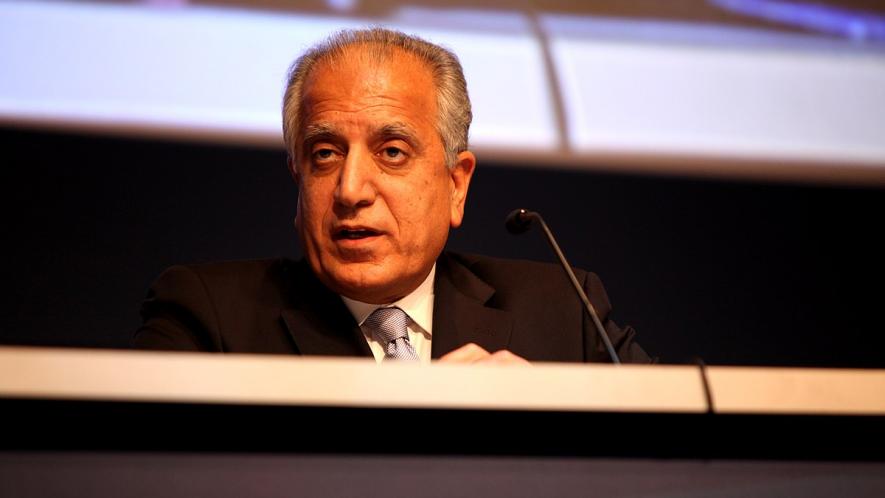20 Years After Invasion, US Proposes a New Afghan Government That Includes Taliban

Zalmay Khalilzad. Photo : Wikimedia Commons
In what seems to be its latest bid to exit the crisis in Afghanistan, the US has reportedly proposed a participatory government in the country with all factions, including the Taliban, TOLOnews reported on Tuesday, March 2. According to the report, the US special representative for Afghanistan Zalmay Khalilzad discussed the proposal in a series of meetings with Afghan president Ashraf Ghani and other top politicians in the country recently amid the continued targeting of civilians and government forces by the Taliban.
Khalilzad was in Kabul on Monday where he met president Ghani and Abdullah Abdullah, the head of Afghanistan’s High Council of National Reconciliation, to discuss the status of last year’s US agreement with Taliban and also the status of intra-Afghan talks. According to TOLOnews, Abdullah Abdullah’s office confirmed that it has received a draft of the plan for the participatory government.
The draft proposes the sidelining of the ongoing peace talks in Doha and initiation of discussions at an international level to decide the details of an interim government with the participation of Taliban which can later get the approval of Afghanistan’s traditional assembly, the Loya Jirga.
The intra-Afghan peace talks in Doha began last year in September following the agreement signed between the Taliban and the US in February 2020 according to which the US had agreed to withdraw all its forces from the country by the end of May 2021. The Taliban had agreed to participate in an intra-Afghan talks with the government in return. However, it never committed to stopping aggression against the government forces.
The fate of the agreement between the US and Taliban is uncertain now since the electoral victory of Joe Biden whose administration has been on the defensive about the withdrawal of forces at a time when there is no tangible result in the intra-Afghan talks and no significant reduction in violence.
Though president Ghani’s office has not officially commented on the proposal yet, in the past he had been critical of such proposals and gone to the extent of saying that the Taliban will not be part of any government in Afghanistan as long as he is alive.
Taliban’s offensive continues
Thousands have been killed in the Afghanistan war since the US-led invasion in 2001. Though the majority of the NATO forces, part of the invasion, have now left the country, the war has not ended. The Taliban which was once the main target of the US invasion has now been identified as a partner in peace by in what looks like a way out of what former US president Donald Trump called “the endless war.” Trump had cited the rising economic cost of the Afghanistan war as a justification of its withdrawal.
Meanwhile, the Taliban has continued its attempts to take over as much of the country as possible. It has capitalized on the vulnerability of successive governments in the country, most of which were established with foreign backing, and the desperation of the US to leave after more than two decades and over USD 2 trillion in costs.
The Taliban intensified its offensive against the Afghan government even as the Trump administration began negotiating with it and now controls a large part of the country’s north-east and south. According to some estimates, the Taliban controls more than 20% of all Afghanistan directly or indirectly. It has also carried out several attacks on civilians and armed forces inside Kabul and other government-controlled areas while simultaneously taking part in the peace process in Doha.
The Taliban recently asked the remaining NATO forces to follow the deal signed last year with the US and leave the country by May. Afghan media also reported preparations by both Taliban and government forces for offensives in the coming months.
Even as recently as Tuesday, March 2, three women working in a media organization were gunned down by armed militants in two incidents of shooting in Jalalabad city, east of capital Kabul, when they were going home after work. Though Taliban’s spokesperson denied its role in the incident, the police claimed that one of the shooters arrested at the time of the incident, was a member of the group.
This takes the toll of journalists and media personnel killed this year alone in Afghanistan to four. In the last six months, a total of 15 media workers and journalists have been killed in the country. In January, the editor-in-chief of Sada-e-Ghor (Voice of Ghor) radio station was killed in the Ghor province. The journalist group, The Afghan Journalist Safety Committee, condemned the attack and issued a statement saying that the government has failed to punish the guilty in the previous killings.
This article was first published in Peoples Dispatch.
Get the latest reports & analysis with people's perspective on Protests, movements & deep analytical videos, discussions of the current affairs in your Telegram app. Subscribe to NewsClick's Telegram channel & get Real-Time updates on stories, as they get published on our website.





















